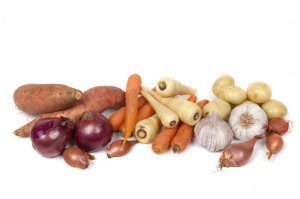
After summer farmers’ markets and roadside stands where colorful fruits and veggies are aplenty, winter can be an uninspiring time to eat healthy. Cold weather often leaves you hungry for comfort foods–most of which are desolate of anything produced by Mother Nature. But just because the warm days of cucumbers, strawberries, and vine-ripened tomatoes are over doesn’t mean eating vegetables have to be as well.

It’s time to get back to your roots–root vegetables, that is. Root veggies–carrots, beets, parsnips, turnips–grow beneath the ground and soak up the minerals and nutrients from the soil as well as the sunshine through their leaves. What is created is a food source that is perfect for winter because of its hardiness and ability to store well if not eaten right away.
If you tend to eat whole foods, root vegetables such as sweet potatoes, carrots, onions, and garlic, are probably already a staple in your diet. However, celery root (or celeriac), rutabagas, and radishes might leave you with your nose turned up instead of thinking “Ooh, yum.” Before you ditch the idea of eating roots though, know what you’ll be missing out on:
- High levels of antioxidants, which help to rid the body of toxins and free radicals
- Beta carotene, which is good for the eyes and preventing cancer
- Vitamin C, which can prevent high blood pressure and heart disease
- Soluble fiber, which helps you to feel full and eat less
Best of all, root vegetable are packed with flavor when prepared properly. Not sure what a parsnip is, let alone how to prepare it? Try these tips to start adding root vegetable to your winter eats.

Raw: Not one for slaving away over a stove top? Try root veggies raw instead. They taste great, but even better, they’re at their most nutritious when not cooked.
Great for: Beets (red and golden), carrots, radishes, jicama, kohlrabi, onions
Try: Use a mandolin to thinly slice the vegetables. Toss them with greens and a light dressing, for a flavorful salad.
Roasted: If raw is a little too earthy for your liking, roasting is a great way to enjoy your roots.
Great for: Sweet potatoes, carrots, baby turnips, garlic, celeriac
Try: Chop vegetables into bite-size chunks and coat with olive oil. Spread the veggies on a baking sheet and sprinkle with salt, pepper, and rosemary or thyme. Bake at 400 for 35-45 minutes, or until brown and tender.
Stew: For a dish that warms the bone on a chilly night, stews are just right.
Great for: Carrots, celeriac, parsnips, turnips, potatoes, onions
Try: Saute onions and olive oil with a mixture of herbs such as sage and parsley. Add chopped beef to the pan and cook until browned. Chop root vegetables and put into a slow cooker with the cooked onions and beef. Add vegetable stock so that ingredients are just covered. Let cook on low for six to eight hours. Before serving, increasing the heat to high, and mix in a cornstarch slurry (whisk two tablespoons of cornstarch and ¼ cup water). This will help to thicken the stew.
Soup: If stews are too heavy for you, a soup is lighter alternative for cold days.
Great for: Leeks, rutabaga, carrots, turnips, sweet potatoes
Try: Saute leeks and olive oil in a saucepan. Add chopped root vegetables, favorite herbs, salt, and pepper. Cover with chicken stock and let simmer until vegetables are tender. Puree the mixture until smooth. If too thick, add water or more stock.
Root vegetables are versatile in how they taste and can be prepared, so if oven roasting wasn’t for you, try grilling. If soup doesn’t satisfy you, make a stew. If you’re not crazy about the flavor of a parsnip, try a rutabaga instead. Don’t let one root or one cooking method have you running. Keep trying until you find what works. The health benefits can’t be beet.
Have a favorite root veggie recipe? Post it in the comments?
[adform]

Leave a Reply